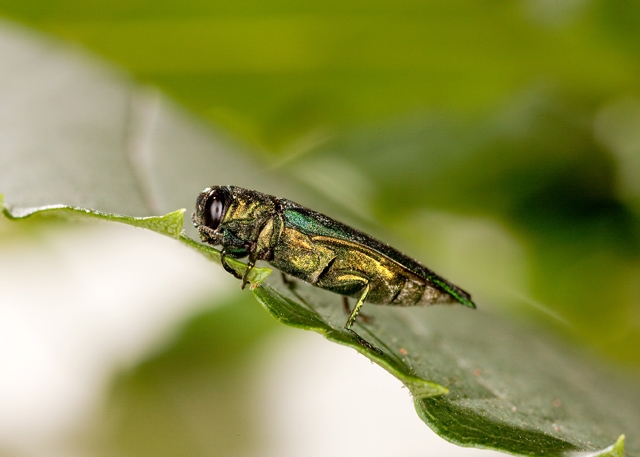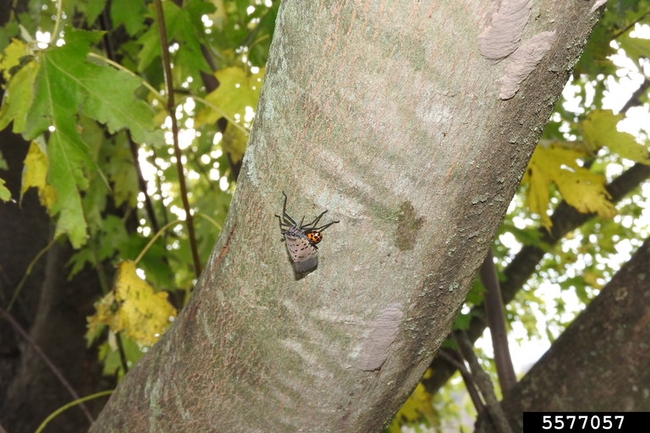Invasive pest species threaten California's natural environment and can have an impact on public health. UC Master Gardeners can help spread the word about these invasive species and how to limit their introduction, spread, and harm. Learn to recognize these pests and distinguish them from look-a-likes. Please share these resources widely with the UC Master Gardener and your local community.
For any of the pests below, please direct clientele to report a finding with their local County Agricultural Commissioner to the CDFA Report a Pest Hotline.
Emerald Ash Borer
The emerald ash borer (or EAB) is an invasive insect that has been found for years in numerous states across the country, but until recently had not been found on the West Coast. In June 2022, EAB was detected in Oregon. This insect feeds on all species of ash trees and has the potential to devastate whole communities of trees.
UC IPM is working on a new web page to cover EAB, but for the time being, please see the California Department of Food and Agriculture website for information about its biology and national distribution.
Spotted Lanternfly
In California, we've been on the lookout for the spotted lanternfly (SLF) for several years. In July 2022, a truck carrying firewood into California from New Jersey (I know, why?) was inspected at a CDFA Border Inspection Station in Truckee and the wood was found to be carrying egg masses of SLF. The wood was destroyed but this is a significant detection.
We need to communicate with California residents about the danger of moving firewood from place to place within the state and especially across state borders. Firewood can harbor many types of invasive pests include SLF but also invasive shothole borers, gold-spotted oak borers, and other very hard to see invasive insects and diseases.
(Video Courtesy of Wisconsin Department of Natural Resources: dnr.wisconsin.gov/topic/Invasives/fact/jumpingWorm.html)
Jumping worm/crazy worm
The invasive jumping worm (Amynthas agrestis) has many common names: Alabama jumpers, Jersey wrigglers, wood eel, crazy worms, snake worms, Asian jumping worm, and crazy snake worms. The jumping worm has been found in Napa and Sonoma Counties. This invasive worm is similar-looking to the common earthworm but thrashes wildly and is said to jump as much as 1 foot off the ground.
Like other earthworms, jumping worms eat fallen leaves and other natural material on the ground. However, these worms voracious eaters and eat so much of the soil “litter” layer, they eat the tiny natural organisms in this layer almost clearing the top soil layer of all life. Many plants can't grow or spread without the layer of leaf litter plus this disrupts the ecosystem of the leaf litter.
Read more about this worm in this article by Oregon State University. UC IPM is compiling information about the worm and where it has been found in California and will publish and announce this information once finished.
There are many other invasive species we are keeping our eyes out for or are trying to manage the spread around the state. Be sure you, your program's volunteers, and local clientele are subscribed to the UC IPM Home & Garden Pest Newsletter, Pests in the Urban Landscape blog, and social media platforms (@ucipmurban) to ensure you are receiving timely updates and news. UC IPM and the statewide UC Master Gardener program will soon be collaborating on projects to increase our educational tools on invasive pests and how to communicate with the public.
Other useful resources for these invasive pests and many others:
- UC IPM Invasive and Exotic Pests web page
- Center for Invasive Species Research at UC Riverside
- Urban & Community IPM webinars https://ucanr.edu/sites/ucipm-community-webinars/
- CDFA target pest web page https://www.cdfa.ca.gov/plant/PDEP/target_pests.html
Questions? Contact
Karey Windbiel-Rojas (she/her)
Associate Director for Urban and Community IPM
Area Urban IPM Advisor serving Yolo, Sacramento, and Solano counties
University of California Division of Agriculture and Natural Resources
UC Statewide Integrated Pest Management Program (UC IPM)
Author - Associate Director for Urban & Community IPM/ Area Urban IPM Advisor

